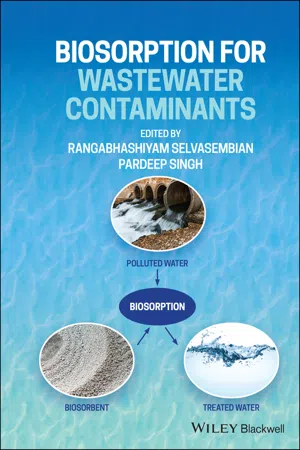
Biosorption for Wastewater Contaminants
Rangabhashiyam Selvasembian, Pardeep Singh, Rangabhashiyam Selvasembian, Pardeep Singh
- English
- ePUB (disponibile sull'app)
- Disponibile su iOS e Android
Biosorption for Wastewater Contaminants
Rangabhashiyam Selvasembian, Pardeep Singh, Rangabhashiyam Selvasembian, Pardeep Singh
Informazioni sul libro
Pollution due to various anthropogenic activities continues to increase. In terms of water pollutants, organic and inorganic pollutants are the most problematic. Although several measures have been proposed and implemented to prevent or reduce contamination, their increased concentration in water bodies has created serious concerns. Over the years, the problem has been aggravated by industrialization, urbanization and the exploitation of natural resources. The direct discharge of wastewater contaminants and their geographical mobilization have caused an increase in concentration in ground, surface, fluvial and residual waters. Extensive information about detection and disposal methods is needed in order to develop technological solutions for a variety of environments, both urban and rural.
This book provides up-to-date information on wastewater contaminants, aimed at researchers, engineers and technologists working in this field. Conventional physicochemical techniques used to remove contaminants from wastewater include ion exchange, precipitation, degradation, coagulation, coating, membrane processes and adsorption. However, these applications have technological and economic limitations, and involve the release of large amounts of chemical reagents and by-products that are themselves difficult to remove. Biosorption - the use of organically generated material as an adsorbent – is attracting new research and scholarship. Thermally-treated calcined biomaterials may be treated to remove heavy metals from wastewater. To ensure the elimination of these contaminants, existing solutions must be integrated with intelligent biosorption functions.
Biosorption for Wastewater Contaminants will find an appreciative audience among academics and postgraduates working in the fields of environmental biotechnology, environmental engineering, wastewater treatment technology and environmental chemistry.
Domande frequenti
Informazioni
1
Industrial Wastewater Contaminants and Their Hazardous Impacts
List of Abbreviations
- AOP:
- Advanced oxidation process
- ASW:
- Artificial sweetener
- BIT:
- Benzisothiazolinone
- BOD:
- Biochemical oxygen demand
- BPA:
- Bisphenol A
- BPD:
- Biocidal Products Directive
- CD:
- Carbendazim
- CEC:
- Contaminant of emerging concern
- CO:
- Carbon monoxide
- COD:
- Chemical oxygen demand
- DBD:
- Dielectric barrier discharge
- DCOIT:
- Dichloroctylisothiazolinone
- DDT:
- Dichlorodiphenyltrichloroethane
- DEET:
- N, N‐Diethyl‐meta‐toluamide
- DR:
- Diuron
- EDC:
- Endocrine disrupting compound
- EPA:
- US Environmental Protection Agency
- FR:
- Flame retardant
- HCB:
- Hexachlorobenzene
- IARC:
- International Agency for Research on Cancer
- IPBC:
- Iodocarb
- IP:
- Isoproturon
- IRG:
- Cybutryn, Irgarol 1051
- MBR:
- Membrane bioreactor
- MCI:
- Methyl chloroisothiazolinone
- MCPP:
- Mecoprop
- MI:
- Methylisothiazolinone
- NOx:
- Nitrogen oxides
- OIT:
- Octylisothiazolone
- PAH:
- Polycyclic aromatic hydrocarbon
- PBB:
- Polybrominated biphenyl
- PCB:
- Polychlorinated biphenyl
- PCP:
- Pentachlorophenol
- PeCB:
- Pentachlorobenzene
- PFOS:
- Perfluorooctanesulfonic acid
- POP:
- Persistent organic pollutant
- PPCPs:
- Pharmaceutical and personal care products
- PPZ:
- Propiconazole
- PT:
- Product type
- SBR:
- Sequencing batch reactor
- SVOC:
- Semi volatile organic compound
- TB:
- Terbutryn
- TBU:
- Tebuconazole
- TOC:
- Total organic carbon
- TOD:
- Total oxygen demand
- VOC:
- Volatile organic compound
- VVOC:
- Very volatile organic compound
- WWTP:
- Wastewater treatment plant